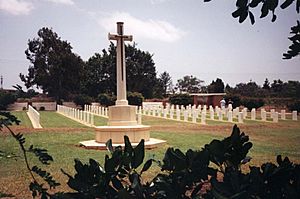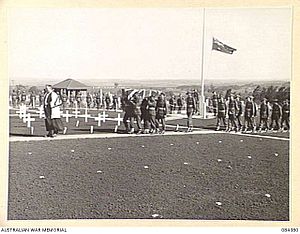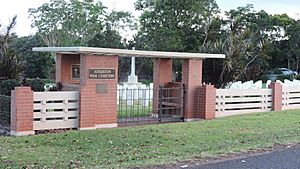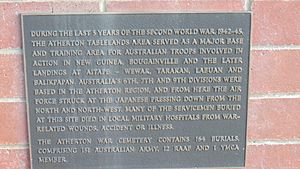Atherton War Cemetery facts for kids
Quick facts for kids Atherton War Cemetery |
|
|---|---|

Atherton War Cemetery
|
|
| Location | Corner of Kennedy Highway and Rockley Road, Atherton, Tablelands Region, Queensland, Australia |
| Built | 1942 |
| Official name: Atherton War Cemetery | |
| Type | state heritage (built) |
| Designated | 19 November 2010 |
| Reference no. | 602765 |
| Lua error in Module:Location_map at line 420: attempt to index field 'wikibase' (a nil value). | |
The Atherton War Cemetery is a special place in Atherton, Australia. It is a heritage-listed cemetery located at the corner of Kennedy Highway and Rockley Road. This cemetery was built in 1942. It was added to the Queensland Heritage Register on November 19, 2010.
Contents
History of the Cemetery
The Atherton War Cemetery was created in 1942. It is part of the larger Atherton Cemetery Reserve. This cemetery holds a special Cross of Sacrifice and 164 graves. These graves belong to soldiers and airmen who died during World War II.
The design of the Atherton War Cemetery follows rules set by the Commonwealth War Graves Commission. This group makes sure that war graves are cared for and remembered. Their design ideas were first used after World War I.
Remembering Fallen Soldiers
The Imperial War Graves Commission was started in Britain in 1917. It later changed its name to the Commonwealth War Graves Commission in 1960. Its main goal was to create lasting memorials for those who died in battle. They also wanted to help families who had lost loved ones.
To do this, the Commission hired famous architects. They decided on some key rules for designing cemeteries:
- Every person who died should have their name on a headstone or memorial.
- Headstones and memorials should be strong and last a long time.
- All headstones should look the same.
- There should be no difference made based on a person's military rank, race, or religion.
These rules helped create peaceful and respectful places. They were designed to be beautiful gardens where people could remember those who served.
Cross of Sacrifice
The main feature in war cemeteries with many burials is the Cross of Sacrifice. It was designed by Sir Reginald Blomfield. This tall stone cross has a bronze sword pointing downwards on its front. It reminds visitors of both the military and the faith of most of the soldiers. Its height changes depending on the size of the cemetery.
Headstones
War cemeteries have headstones that all look alike. They are usually placed in perfectly straight rows. At the top of each headstone, you can see the country's symbol or the soldier's army badge. Below that, it shows their rank, name, army unit, date of death, and age. Sometimes, families also added a special message.
Garden Settings
The War Graves Commission wanted war cemeteries to be calm and beautiful gardens. This was to help comfort families who were grieving. Famous garden designers helped make these places peaceful. They used traditional garden plants, especially flowering ones.
After World War I, the Commission built many cemeteries. When World War II began, they had to do it all again. They built 559 new cemeteries and 36 new memorials. They also cared for the graves of 600,000 Commonwealth soldiers from World War II.
Atherton's Role in WWII
The Atherton War Cemetery was created in 1942. This was when the Tablelands area became a major base for the Australian Army. The area between Atherton and Cairns was used for training Australian troops. These soldiers were getting ready for battles in New Guinea and other places.
Many army camps were set up in the Atherton region. Soldiers learned about jungle warfare there. Wounded soldiers were taken to nearby hospitals, like the one at Rocky Creek.
The first person buried in the Atherton War Cemetery was Gunner Andrew Mervyn Hemsworth. He died on January 4, 1943. In 1944, the cemetery was redesigned. It was laid out in a neat, symmetrical pattern with gravel paths. A Cross of Sacrifice was placed in the center.
At first, the graves had white wooden crosses. Later, these were replaced with marble headstones. Photos show this change happened between 1944 and 1949.
The last three burials happened after an explosion in 1946. Three soldiers were cleaning up an ammunition dump nearby. They were badly hurt and died soon after. They were buried at the Atherton War Cemetery.
The cemetery now has 164 graves. These soldiers came from 19 different Australian army groups. One grave belongs to a member of the Young Men's Christian Association.
In 1948, an agreement was made to keep the Atherton War Cemetery as a war cemetery forever. The Commonwealth War Graves Commission helps maintain it.
There are 14 war cemeteries and special burial plots in Queensland. These include places like Lutwyche, Bundaberg, and Townsville. The Office of Australian War Graves takes care of these cemeteries.
What the Cemetery Looks Like
The Atherton War Cemetery is in the north-western part of the Atherton Cemetery Reserve. You can find it near Rockley Road and the Kennedy Highway.
The main entrance is on the northern side. It has brick pillars and a concrete fence. There are also wrought iron gates. Inside the entrance is a shelter with a bench. You can find a visitors' book and cemetery register there.
Two bronze plaques are attached to the shelter. One plaque says that the Commonwealth War Graves Commission maintains the cemetery. The other plaque explains why the Atherton Tablelands was important during World War II. It also tells you how many soldiers are buried there.
The cemetery has 164 graves. All the graves have white marble headstones that look the same. They are rectangular with a rounded top. Each headstone has military symbols, the soldier's name, and rank. Some also have a short message chosen by their family. The headstones are arranged in 11 neat rows.
The Cross of Sacrifice is about 7.5 meters from the middle row of headstones. It stands about 4 meters tall. It is made of sandstone and has bronze swords on two sides.
The garden beds around the cemetery are important to its look. The plants in them are changed and updated over time. This keeps the cemetery looking neat and respectful.
Why it's Important
The Atherton War Cemetery is important for several reasons:
- It shows Queensland's history: This cemetery shows how Queensland was involved in World War II. The Atherton Tablelands was a very important military area during the war. The cemetery is a memorial to the Australian soldiers and airmen who died fighting, especially in New Guinea.
- It shows how war cemeteries are designed: The cemetery shows the special design rules set by the Commonwealth War Graves Commission. These rules include uniform headstones, the Cross of Sacrifice, and well-kept gardens. These features make it a dignified and respectful memorial site.
- It has a special feeling: The Atherton War Cemetery has a unique and solemn feeling. The neat rows of white marble headstones and the Cross of Sacrifice create a very formal and peaceful place. This makes it stand out from the general cemetery next to it.
See Also
- List of war memorials in Queensland






